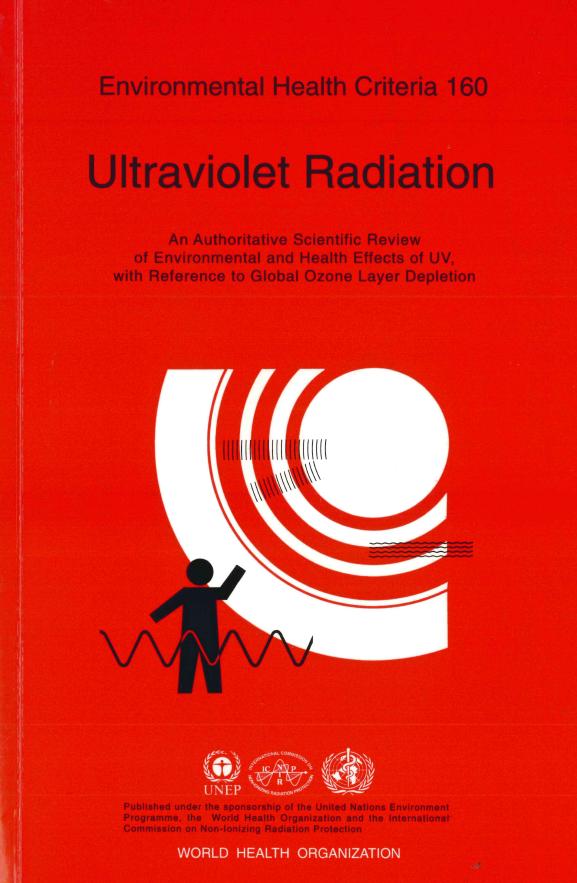EHC 160 on UV Radiation - 1994
ISBN: 92-4-157160-8

Environmental Health Criteria 160: Ultraviolet Radiation. Geneva; World Health Organization; 1994.
Published under the joint sponsorship of the United Nations Environment Programme, the Commission on Non-Ionizing Radiation Protection, and the World Health Organization - © WHO, Geneva, 1994
WHO describes the monograph as "a review of the data on the effects of UV exposure on biological systems pertinent to the evaluation of human health risks. Its purpose is to give an overview of the known biological effects of UV, identify gaps in knowledge and provide direction for further research. This monograph will assist health authorities, regulatory and similar agencies to provide guidance on health risks from exposure to UV and limits for occupational and general public exposure.
Subjects reviewed include: the physical characteristics of UV; measurement techniques; applications and sources of exposure; mechanisms of interaction; biological effects; guidance on protective measures; and recommendations on exposure limits."
Table of Contents
1. SUMMARY AND CONCLUSIONS
1.1. Physical characteristics
1.2. Action spectrum and minimum erythemal dose
1.3. Cellular and molecular studies
1.4. Animal studies
1.5. Health effects on humans
1.5.1. Skin
1.5.2. Immune system
1.5.3. Eye
1.6. Environment
1.7. Guidelines on exposure limits and protective measures
2. PHYSICAL CHARACTERISTICS
2.1. Electromagnetic spectrum
2.2. Radiometric quantities and units
2.3. UV production
2.3.1. Thermal emitters
2.3.2. Electrical gaseous discharges
2.3.3. Stimulated emission
2.4. Summary
3. UV SOURCES
3.1. The sun
3.1.1. Factors affecting solar UV levels
3.1.2. Ozone depletion effects
3.1.3. Trends in UV 19
3.1.4. Theoretical models
3.1.5. UV monitoring
3.1.6. Analysis of UV data
3.1.7. Conclusions
3.2. Artificial sources
3.2.1. Incandescent sources
3.2.2. Gaseous discharge sources
3.2.3. Gas welding
3.2.4. Arc welding
3.2.5. Lasers
3.2.6. Sunbeds
4. HUMAN EXPOSURE
4.1. Sunlight
4.2. Skin exposure geometry
4.3. Ocular exposure geometry
4.4. Workplace
4.4.1. Outdoor work
4.4.2. Indoor work
4.4.3. Research
4.4.4. Commerce
4.4.5. Medicine and dentistry
4.5. Elective exposure
5. DOSIMETRIC CONCEPTS
5.1. Interaction of UV with matter
5.2. Biological weighting factors and spectrally weighted quantities
5.3. Measurement techniques
5.3.1. Detectors
5.3.2. Radiometers
5.3.3. Spectroradiometers
5.3.4. Personal dosimetry
5.4. Calibration
6. CELLULAR AND MOLECULAR STUDIES
6.1. Introduction
6.2. Interactions with biomolecules
6.2.1. Cellular chromophores
6.2.2. Cellular targets
6.3. Action spectra
6.4. Biomolecular damage
6.4.1. Nucleic acids
6.4.2. Membranes
6.4.3. Proteins
6.5. Cellular defenses
6.5.1. DNA
6.5.2. Human excision repair disorders
6.5.3. Antioxidant pathways
6.5.4. Summary
6.6. Cellular consequences of damage
6.6.1. Membrane disruption
6.6.2. Activation of genes
6.6.3. Cell death
6.6.4. Mutation, chromosomal damage and transformation
6.7. Conclusions
7. ANIMAL STUDIES
7.1. Skin carcinogenesis
7.1.1. Domestic animals
7.1.2. Experimental animals
7.1.3. Interactions between radiations of different wavelengths
7.1.4. Dose response
7.1.5. Effect of pattern of exposure
7.1.6. Action spectrum
7.1.7. Interaction between UV and chemicals
7.1.8. Mechanisms of UV carcinogenesis
7.1.9. Conclusions
7.2. Immune responses
7.2.1. Immune function assays
7.2.2. Susceptibility to rumours
7.2.3. Susceptibility to infectious disease
7.2.4. Susceptibility to immunologically-mediated disease
7.2.5. Conclusions
7.3. Ocular studies
7.3.1. Introduction
7.3.2. General effects
7.3.3. Caractogenesis
7.3.4. Retinal effects
8. HUMAN STUDIES: THE SKIN
8.1. Characteristics
8.1.1. Structure and optical properties
8.1.2. Skin types
8.2. Beneficial effects
8.2.1. Vitamin D3
8.2.2. Skin adaptation
8.2.3. Other benefits
8.3. Acute effects
8.3.1. Erythema and sunburn
8.3.2. Skin pigmentation and tanning
8.3.3. Photosensitization
8.4. Chronic effects on the skin other than cancer
8.5. Cancer
8.5.1. Nonmelanocytic skin cancer
8.5.2. Cutaneous melanoma
8.5.3. Cancer of the lip
8.5.4. Ocular cancers
8.5.5. Other cancers
8.5.6. Action spectrum
8.5.7. Dose response
8.5.8. Effects of pattern of exposure
8.5.9. Interactions between UV and other agents
8.5.10. Mechanisms of UV carcinogenesis
8.6. Conclusions
9. HUMAN STUDIES: IMMUNE FUNCTION
9.1. Immune function assays
9.2. Susceptibility to tumours, infectious and autoimmune diseases
9.3. Conclusions
10. HUMAN STUDIES: THE EYE
10.1. Introduction
10.2. The eye
10.3. Study design
10.4. Diseases of the external eye
10.4.1. Photokeratitis and photoconjunctivitis
10.4.2. Climatic droplet keratopathy
10.4.3. Pinguecula
10.4.4. Pterygium
10.4.5. Hyperkeratosis, carcinoma-in-situ, and squamous cell carcinoma of the conjunctiva
10.5. Diseases of the lens
10.5.1. Cataract
10.5.2. Exfoliation syndrome
10.5.3. Anterior lens capsule
10.6. Diseases of the choroid and retina
10.6.1. Uveal melanoma
10.6.2. Age-related macular degeneration
10.7. Conclusions
11. EFFECTS ON PLANT AND AQUATIC ECOSYSTEMS
11.1. Introduction
11.2. Effects on terrestrial plants
11.2.1. UV penetration into the leaf
11.2.2. Changes in growth
11.2.3. Effects on plant function
11.2.4. Species competition
11.2.5. Plant diseases
11.2.6. UV-protection systems
11.3. Effects on aquatic ecosystems
11.3.1. Effects on phytoplankton
11.3.2. UV increase and primary biomass production
11.4. Conclusions
12. HEALTH HAZARD ASSESSMENT
12.1. Introduction
12.2. Elective exposures
12.2.1. Medical exposures
12.2.2. Phototherapy of seasonal effective disorder (SED)
12.2.3. Sunbeds
12.2.4. Sunbathing
12.3. Adventitious exposures
12.3.1. Outdoor exposures
12.3.2. Artificial sources
13. INTERNATIONAL GUIDELINES ON EXPOSURE STANDARDS
14. PROTECTIVE MEASURES
14.1. Introduction
14.2. Education
14.3. Protection factors
14.4. Clothing
14.5. Sunscreens
14.6. Tanning devices
14.7. Occupational protection
14.8. Protection in medicine and dentistry
14.9. Nutrition
14.10. Additional protective agents
14.11. Eye protection
15. FUTURE RESEARCH
15.1. Introduction
15.2. INTERSUN
15.3. Solar and personal UV monitoring
15.3.1. Solar monitoring
15.3.2. Personal monitoring
15.4. Terrestrial plants
15.5. Aquatic ecosystems
15.6. Human health
15.6.1. Skin
15.6.2. Immune system
15.6.3. Eye
15.7. Laboratory studies
15.8. Education
15.9. Administration
16. PREVIOUS EVALUATIONS BY INTERNATIONAL BODIES
16.1. United Nations Environment Programme
16.1.1. Ozone
16.1.2. Human health
16.2. International Agency for Research on Cancer
16.3. World Health Organization
16.4. International Commission on Non-Ionising
